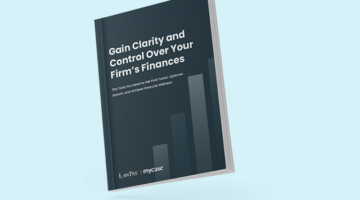
The D.C. Circuit has made an important announcement to litigants — don’t use Garamond. Yup, the font. They announced this week they’d really like you to use Century or Times New Roman and stay the hell away from Garamond. Though, strictly speaking it isn’t a rule, just advice… advice you should probably take.
According to the proclamation, the issue is legibility and Garamond’s smaller appearance is the reason it’s being shunned. Though Federal Rule of Appellate Procedure 32(a)(5) already requires all typeface be in 14 pt fonts, which would seem to mitigate the smaller stature of Garamond, but, I digress. Others point to the illegibility of italics in Garamond, and that the section symbol, which obvi comes up a lot in legal writing, is ugly in that font.

Take Control Of Your Firm’s Finances With Tools Built For Success
Position your firm for long-term growth with better financial visibility and control. Learn how to track performance, manage spending, and plan strategically—download the full e-book now.
But Garamond is pretty popular, particularly in pop culture, and switching to it could save the federal government gobs of money, not that it seems to matter to the D.C. Circuit:
Consider the gauntlet thrown down. The font, often described as elegant and traditional, dates back to the 16th century. Created by French engraver Claude Garamond, the typeface is still popular today: You can find it in Neutrogena’s logo, Harry Potter books, and the Hunger Games series. In 2014, one Pennsylvania student proposed the font as a cost-saving, printer-efficient typeface that could save the government some $400 million in printing costs.
But as it’s been pointed out on legal Twitter, the displeasure of the D.C. Circuit might just be worth it if you’re butting up against a hard page count:
The D.C. Circuit has a point. Garamond is more compact than most fonts. For most appellate filings, its use will shave several pages off a brief. For that reason, it's long been a last resort for page-limited filings. But I could see people thinking it results in eyestrain. 1/2 https://t.co/6iyQP6Y2uu pic.twitter.com/o9W7OAo8jB
— John Elwood (@johnpelwood) March 17, 2021

How MyCase’s Smart Spend Can Help Increase Your Profits
This tweak to your financial management seems like a no-brainer.
Hogan Lovells partner Sean Marotta thinks the D.C. Circuit’s font stance is a subtle way to call out the U.S. Department of Justice’s Civil Appellate staff, as an entity that “(semi-famously) uses Garamond in its briefs.”
In what I think is a subtweet of the Civil Appellate Staff, the #CADC updates its Handbook of Internal Practice and Procedure to discourage the use of Garamond. (I think Garamond's fine except for the ugly section symbol, but I guess the Court disagrees?)#AppellateTwitter pic.twitter.com/vFhzKVlvOR
— Sean Marotta (@smmarotta) March 17, 2021
Regardless, it’s useful to have the court’s preferences, for whatever they’re worth, out in the open. To paraphrase a famous usage of Garamond, may the fonts be ever in your favor.
 Kathryn Rubino is a Senior Editor at Above the Law, and host of The Jabot podcast. AtL tipsters are the best, so please connect with her. Feel free to email her with any tips, questions, or comments and follow her on Twitter (@Kathryn1).
Kathryn Rubino is a Senior Editor at Above the Law, and host of The Jabot podcast. AtL tipsters are the best, so please connect with her. Feel free to email her with any tips, questions, or comments and follow her on Twitter (@Kathryn1).